Papers by Cristelle Rodriguez
Neurobiology of Aging, Mar 1, 2020
This is a PDF file of an article that has undergone enhancements after acceptance, such as the ad... more This is a PDF file of an article that has undergone enhancements after acceptance, such as the addition of a cover page and metadata, and formatting for readability, but it is not yet the definitive version of record. This version will undergo additional copyediting, typesetting and review before it is published in its final form, but we are providing this version to give early visibility of the article. Please note that, during the production process, errors may be discovered which could affect the content, and all legal disclaimers that apply to the journal pertain.
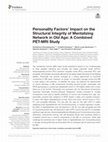
Frontiers in Psychiatry, Nov 17, 2020
The mentalizing network (MN) treats social interactions based on our understanding of other peopl... more The mentalizing network (MN) treats social interactions based on our understanding of other people's intentions and includes the medial prefrontal cortex (mPFC), temporoparietal junction (TPJ), posterior cingulate cortex (PCC), precuneus (PC), and amygdala. Not all elders are equally affected by the aging-related decrease of mentalizing abilities. Personality has recently emerged as a strong determinant of functional connectivity in MN areas. However, its impact on volumetric changes across the MN in brain aging is still unknown. To address this issue, we explored the determinants of volume decrease in MN components including amyloid burden, personality, and APOE genotyping in a previously established cohort of 130 healthy elders with a mean follow-up of 54 months. Personality was assessed with the Neuroticism Extraversion Openness Personality Inventory-Revised. Regression models corrected for multiple comparisons were used to identify predictors of volume loss including time, age, sex, personality, amyloid load, presence of APOE epsilon 4 allele, and cognitive evolution. In cases with higher Agreeableness scores, there were lower volume losses in PCC, PC, and amygdala bilaterally. This was also the case for the right mPFC in elders displaying lower Agreeableness and Conscientiousness. In multiple regression models, the effect of Agreeableness was still observed in left PC and right amygdala and that of Conscientiousness was still observed in right mPFC volume loss (26.3% of variability, significant age and sex). Several Agreeableness (Modesty) and Conscientiousness (order, dutifulness, achievement striving, and self-discipline) facets were positively related to increased volume loss in cortical components of the MN. In conclusion, these data challenge the beneficial role of higher levels of Agreeableness and Conscientiousness in old age, showing that they are associated with an increased rate of volume loss within the MN.
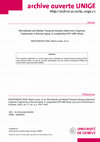
Journal of Alzheimer's Disease, Oct 13, 2020
Background: The cognitive trajectories in normal aging may be affected by medial temporal atrophy... more Background: The cognitive trajectories in normal aging may be affected by medial temporal atrophy (MTA) and amyloid burden, as well as vascular pathologies such as cortical microbleeds (CMB) and white matter hyperintensities (WMH). Objective: We addressed here the role of imaging markers in their prediction in a real-world situation. Methods: We performed a 4.5-year longitudinal study in 90 older community-dwellers coupling two neuropsychological assessments, MTA estimated with the Schelten's scale, number of CMB, and WMH evaluated with the Fazekas score at inclusion and follow-up, visual rating of amyloid PET and glucose hypometabolism at follow-up, and APOE genotyping. Regression models were built to explore the association between the continuous cognitive score (CCS) and imaging parameters. Results: The number of strictly lobar CMB at baseline (4 or more) was related to a 5.5-fold increase of the risk of cognitive decrement. This association persisted in multivariable models explaining 10.6% of the CCS decrease variance. MTA, and Fazekas score at baseline and amyloid positivity or abnormal FDG PET, were not related to the cognitive outcome. The increase of right MTA at follow-up was the only correlate of CCS decrease both in univariate and multivariable models explaining 9.2% of its variance. Conclusion: The present data show that the accumulation of more than four CMB is associated with significant cognitive decrement over time in highly educated elderly persons. They also reveal that the progressive deterioration of cognitive performance within the age-adjusted norms is also related to the increase of visually assessed MTA.
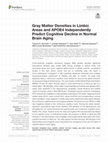
Frontiers in Aging Neuroscience, Jun 28, 2019
Cross-sectional magnetic resonance imaging (MRI) studies reported significant associations betwee... more Cross-sectional magnetic resonance imaging (MRI) studies reported significant associations between gray matter (GM) density changes in various limbic and neocortical areas and worst cognitive performances in elderly controls. Longitudinal studies in this field remain scarce and led to conflicting data. We report a clinico-radiological investigation of 380 cognitively preserved individuals who undergo neuropsychological assessment at baseline and after 18 months. All cases were assessed using a continuous cognitive score taking into account the global evolution of neuropsychological performances. The vast majority of Mini Mental State Examination (MMSE) 29 and 30 cases showed equal or worst performance at follow-up due to a ceiling effect. GM densities, white matter hyperintensities and arterial spin labeling (ASL) values were assessed in the hippocampus, amygdala, mesial temporal and parietal cortex at inclusion using 3 Tesla MRI Scans. Florbetapir positron emission tomography (PET) amyloid was available in a representative subsample of 64 cases. Regional amyloid uptake ratios (SUVr), mean cortical SUVr values (mcSUVr) and corresponding z-scores were calculated. Linear regression models were built to explore the association between the continuous cognitive score and imaging variables. The presence of an APOE-ε4 allele was negatively related to the continuous cognitive score. Among the areas studied, significant associations were found between GM densities in the hippocampus and amygdala but not mesial temporal and parietal areas and continuous cognitive score. Neither ASL values, Fazekas score nor mean and regional PET amyloid load was related to the cognitive score. In multivariate models, the presence of APOE-ε4 allele and GM densities in the hippocampus and amygdala were independently associated with worst cognitive evolution at follow-up. Our data support the idea that early GM damage in the hippocampus and amygdala occur long before the emergence of the very first signs of cognitive failure in brain aging.
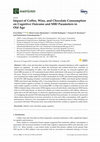
Nutrients, Oct 1, 2018
Coffee, wine and chocolate are three frequently consumed substances with a significant impact on ... more Coffee, wine and chocolate are three frequently consumed substances with a significant impact on cognition. In order to define the structural and cerebral blood flow correlates of self-reported consumption of coffee, wine and chocolate in old age, we assessed cognition and brain MRI measures in 145 community-based elderly individuals with preserved cognition (69 to 86 years). Based on two neuropsychological assessments during a 3-year follow-up, individuals were classified into stable-stable (52 sCON), intermediate (61 iCON) and deteriorating-deteriorating (32 dCON). MR imaging included voxel-based morphometry (VBM), tract-based spatial statistics (TBSS) and arterial spin labelling (ASL). Concerning behavior, moderate consumption of caffeine was related to better cognitive outcome. In contrast, increased consumption of wine was related to an unfavorable cognitive evolution. Concerning MRI, we observed a negative correlation of wine and VBM in bilateral deep white matter (WM) regions across all individuals, indicating less WM lesions. Only in sCON individuals, we observed a similar yet weaker association with caffeine. Moreover, again only in sCON individuals, we observed a significant positive correlation between ASL and wine in overlapping left parietal WM indicating better baseline brain perfusion. In conclusion, the present observations demonstrate an inverse association of wine and coffee consumption with cognitive performances. Moreover, low consumption of wine but also moderate to heavy coffee drinking was associated with better WM preservation and cerebral blood-flow notably in cognitively stable elders.
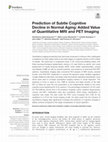
Frontiers in Aging Neuroscience, Jul 12, 2021
Quantitative imaging processing tools have been proposed to improve clinic-radiological correlati... more Quantitative imaging processing tools have been proposed to improve clinic-radiological correlations but their added value at the initial stages of cognitive decline is still a matter of debate. We performed a longitudinal study in 90 community-dwelling elders with three neuropsychological assessments during a 4.5 year follow-up period, and visual assessment of medial temporal atrophy (MTA), white matter hyperintensities, cortical microbleeds (CMB) as well as amyloid positivity, and presence of abnormal FDG-PET patterns. Quantitative imaging data concerned ROI analysis of MRI volume, amyloid burden, and FDG-PET metabolism in several AD-signature areas. Multiple regression models, likelihood-ratio tests, and areas under the receiver operating characteristic curve (AUC) were used to compare quantitative imaging markers to visual inspection. The presence of more or equal to four CMB at inclusion and slight atrophy of the right MTL at follow-up were the only parameters to be independently related to the worst cognitive score explaining 6% of its variance. This percentage increased to 24.5% when the ROI-defined volume loss in the posterior cingulate cortex, baseline hippocampus volume, and MTL metabolism were also considered. When binary classification of cognition was made, the area under the ROC curve increased from 0.69 for the qualitative to 0.79 for the mixed imaging model. Our data reveal that the inclusion of quantitative imaging data significantly increases the prediction of cognitive changes in elderly controls compared to the single consideration of visual inspection.
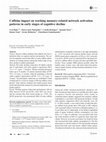
Neuroradiology, Mar 13, 2017
Purpose Recent evidence indicates that caffeine may have a beneficial effect on cognitive decline... more Purpose Recent evidence indicates that caffeine may have a beneficial effect on cognitive decline and dementia. The current investigation assessed the effect of acute caffeine administration on working memory during the earliest stage of cognitive decline in elderly participants. Methods The study includes consecutive 45 elderly controls and 18 individuals with mild cognitive impairment (MCI, 71.6 ± 4.7 years, 7 females). During neuropsychological follow-up at 18 months, 24 controls remained stable (sCON, 70.0 ± 4.3 years, 11 women), while the remaining 21 showed subtle cognitive deterioration (dCON, 73.4 ± 5.9 years, 14 women). All participants underwent an established 2-back working task in a crossover design of 200 mg caffeine versus placebo. Data analysis included task-related general linear model and functional connectivity tensorial independent component analysis. Results Working memory behavioral performances did not differ between sCON and dCON, while MCI was slower and less accurate than both control groups (p < 0.05). The dCON group had a less pronounced effect of acute caffeine administration essentially restricted to the right hemisphere (p < 0.05 corrected) and reduced default mode network (DMN) deactivation compared to sCON (p < 0.01 corrected). Conclusion dCON cases are characterized by decreased sensitivity to caffeine effects on brain activation and DMN deactivation. These complex fMRI patterns possibly reflect the instable status of these cases with intact behavioral performances despite already existing functional alterations in neocortical circuits.
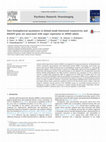
Psychiatry Research: Neuroimaging, Nov 1, 2017
Attention deficit hyperactivity disorder (ADHD) is accompanied by resting-state alterations, incl... more Attention deficit hyperactivity disorder (ADHD) is accompanied by resting-state alterations, including abnormal activity, connectivity and asymmetry of the default-mode network (DMN). Concurrently, recent studies suggested a link between ADHD and the presence of polymorphisms within the gene BAIAP2 (i.e., brain-specific angiogenesis inhibitor 1-associated protein 2), known to be differentially expressed in brain hemispheres. The clinical and neuroimaging correlates of this polymorphism are still unknown. We investigated the association between BAIAP2 polymorphisms and DMN functional connectivity (FC) asymmetry as well as behavioral measures in ADHD adults. Resting-state fMRI was acquired from 30 ADHD and 15 healthy adults. For each subject, rs7210438 and rs8079626 within the gene BAIAP2 were genotyped. ADHD severity, impulsiveness and anger were assessed for the ADHD group. Using multivariate analysis of variance, we found that genetic features do have an impact on DMN FC asymmetry. In particular, polymorphism rs8079626 affects medial frontal gyrus and inferior parietal lobule connectivity asymmetry, lower for AA than AG/GG carriers. Further, when combining FC asymmetry and the presence of the rs8079626 variant, we successfully predicted increased externalization of anger in ADHD. In conclusion, a complex interplay between genetic vulnerability and interhemispherical DMN FC asymmetry plays a role in emotion regulation in adult ADHD.
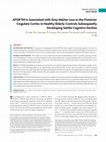
American Journal of Neuroradiology, May 11, 2017
BACKGROUND AND PURPOSE: The presence of apolipoprotein E4 (APOE*E4) is the strongest currently kn... more BACKGROUND AND PURPOSE: The presence of apolipoprotein E4 (APOE*E4) is the strongest currently known genetic risk factor for Alzheimer disease and is associated with brain gray matter loss, notably in areas involved in Alzheimer disease pathology. Our objective was to assess the effect of APOE*E4 on brain structures in healthy elderly controls who subsequently developed subtle cognitive decline. MATERIALS AND METHODS: This prospective study included 382 community-dwelling elderly controls. At baseline, participants underwent MR imaging at 3T, extensive neuropsychological testing, and genotyping. After neuropsychological follow-up at 18 months, participants were classified into cognitively stable controls and cognitively deteriorating controls. Data analysis included whole-brain voxelbased morphometry and ROI analysis of GM. RESULTS: APOE*E4-related GM loss at baseline was found only in the cognitively deteriorating controls in the posterior cingulate cortex. There was no APOE*E4-related effect in the hippocampus, mesial temporal lobe, or brain areas not involved in Alzheimer disease pathology. Controls in the cognitively deteriorating group had slightly lower GM concentration in the hippocampus at baseline. Higher GM densities in the hippocampus, middle temporal lobe, and amygdala were associated with a decreased risk for cognitively deteriorating group status at follow-up. CONCLUSIONS: APOE*E4-related GM loss in the posterior cingulate cortex (an area involved in Alzheimer disease pathology) was found only in those elderly controls who subsequently developed subtle cognitive decline but not in cognitively stable controls. This finding might explain the partially conflicting results of previous studies that typically did not include detailed neuropsychological assessment and follow-up. Most important, APOE*E4 status had no impact on GM density in areas affected early by neurofibrillary tangle formation such as the hippocampus and mesial temporal lobe. ABBREVIATIONS: AD ϭ Alzheimer disease; APOE ϭ apolipoprotein E; dCON ϭ cognitively deteriorating controls; MCI ϭ mild cognitive impairment; sCON ϭ cognitively stable controls
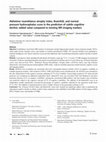
European Radiology, Apr 29, 2022
Objectives Established visual brain MRI markers for dementia include hippocampal atrophy (mesio-t... more Objectives Established visual brain MRI markers for dementia include hippocampal atrophy (mesio-temporal atrophy MTA), white matter lesions (Fazekas score), and number of cerebral microbleeds (CMBs). We assessed whether novel quantitative, artificial intelligence (AI)-based volumetric scores provide additional value in predicting subsequent cognitive decline in elderly controls. Methods A prospective study including 80 individuals (46 females, mean age 73.4 ± 3.5 years). 3T MR imaging was performed at baseline. Extensive neuropsychological assessment was performed at baseline and at 4.5-year follow-up. AI-based volumetric scores were derived from 3DT1: Alzheimer Disease Resemblance Atrophy Index (AD-RAI), Brain Age Gap Estimate (BrainAGE), and normal pressure hydrocephalus (NPH) index. Analyses included regression models between cognitive scores and imaging markers. Results AD-RAI score at baseline was associated with Corsi (visuospatial memory) decline (10.6% of cognitive variability in multiple regression models). After inclusion of MTA, CMB, and Fazekas scores simultaneously, the AD-RAI score remained as the sole valid predictor of the cognitive outcome explaining 16.7% of its variability. Its percentage reached 21.4% when amyloid positivity was considered an additional explanatory factor. BrainAGE score was associated with Trail Making B (executive functions) decrease (8.5% of cognitive variability). Among the conventional MRI markers, only the Fazekas score at baseline was positively related to the cognitive outcome (8.7% of cognitive variability). The addition of the BrainAGE score as an independent variable significantly increased the percentage of cognitive variability explained by the regression model (from 8.7 to 14%). The addition of amyloid positivity led to a further increase in this percentage reaching 21.8%. Conclusions The AI-based AD-RAI index and BrainAGE scores have limited but significant added value in predicting the subsequent cognitive decline in elderly controls when compared to the established visual MRI markers of brain aging, notably MTA, Fazekas score, and number of CMBs.
Neurobiology of Aging, May 1, 2020
This is a PDF file of an article that has undergone enhancements after acceptance, such as the ad... more This is a PDF file of an article that has undergone enhancements after acceptance, such as the addition of a cover page and metadata, and formatting for readability, but it is not yet the definitive version of record. This version will undergo additional copyediting, typesetting and review before it is published in its final form, but we are providing this version to give early visibility of the article. Please note that, during the production process, errors may be discovered which could affect the content, and all legal disclaimers that apply to the journal pertain.
Alzheimers & Dementia, Jul 1, 2019

Neurodegenerative Diseases, 2019
Background: Hippocampal volume loss (HVL), PET-documented brain amyloid accumulation, and APOE-ε4... more Background: Hippocampal volume loss (HVL), PET-documented brain amyloid accumulation, and APOE-ε4 status are predictive biomarkers of the transition from mild cognitive impairment to Alzheimer disease (AD). In asymptomatic cases, the role of these biomarkers remains ambiguous. In contrast to the idea that HVL occurs in late phases of neurodegeneration, recent contributions indicate that it might occur before abnormal amyloid PET occurrence in elderly subjects and that its severity could be only marginally related to APOE variants. Using a longitudinal design, we examined the determinants of HVL in our sample, i.e., brain amyloid burden and the presence of APOE-ε4, and made a longitudinal assessment of cognitive functions. Methods: We performed a 4.5-year longitudinal study on 81 elderly community dwellers (all right-handed;, 48 (59.3%) women; mean age 73.7 ± 3.7 years) including MRI at baseline and follow-up, PET amyloid during follow-up, neuropsychological assessment at 18 and 54 months, and APOE genotyping. All cases were assessed using a continuous cognitive score (CCS) that took into account the global evolution of neuropsychological performance. Linear regression models were used to identify predictors of HVL. Results: There was a negative association between the CCS and HVL bilaterally. In multivariate models adjusting for demographic variables, the presence of APOE-ε4 was related to increased HVL bilaterally. A trend of significance was observed with respect to the impact of amyloid positivity on HVL in the left hemisphere. No significant interaction was found between amyloid positivity and the APOE-ε4 allele. Conclusion: The progressive decrement of neuropsychological performance is associated with HVL long before the emergence of clinically overt symptoms. In this cohort of healthy individuals, the presence of the APOE-ε4 allele was shown to be an independent predictor of worst hippocampal integrity in asymptomatic cases independently of amyloid positivity.
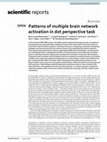
Scientific Reports
In this functional MRI (fMRI) study on 82 healthy adults using the dot perspective task, inconsis... more In this functional MRI (fMRI) study on 82 healthy adults using the dot perspective task, inconsistency of perspectives was associated with a significant increase of the mean reaction time and number of errors both in Self and Other conditions. Unlike the Arrow (non-mentalizing), the Avatar (mentalizing) paradigm was characterized by the recruitment of parts of the mentalizing and salience networks. These data provide experimental evidence supporting the fMRI distinction between mentalizing and non-mentalizing stimuli. A widespread activation of classical theory of mind (ToM) areas but also of salience network and decision making areas was observed in the Other compared to Self-conditions. Compared to Self-Consistent, Self-Inconsistent trials were related to increased activation in the lateral occipital cortex, right supramarginal and angular gyrus as well as inferior, superior and middle frontal gyri. Compared to the Other-Consistent, Other-Inconsistent trials yielded strong activat...

Frontiers in Human Neuroscience
Previous studies showed that neurotypical adults are able to engage in unconscious analyses of ot... more Previous studies showed that neurotypical adults are able to engage in unconscious analyses of others’ mental states in the context of automatic perspective taking and experience systematic difficulties when judging the conflicts between their own (Self) and another’s (Other) perspective. Several functional MRI (fMRI) studies reported widespread activation of mentalizing, salience, and executive networks when adopting the Other compared to Self perspective. This study aims to explore whether cognitive and emotional parameters impact on brain reactivity in dot perspective task (dPT). We provide here an fMRI analysis based on individual z-scores in eighty-two healthy adults who underwent the Samson’s dPT after detailed assessment of fluid intelligence, attention, levels of alexithymia and social cognition abilities. Univariate regression models were used to explore the association between brain activation patterns and psychological variables. There was a strong positive association be...
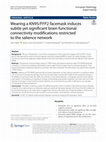
European Radiology Experimental
Background The use of facemasks is one of the consequences of the coronavirus disease 2019 (COVID... more Background The use of facemasks is one of the consequences of the coronavirus disease 2019 (COVID-19) pandemic. We used resting-state functional magnetic resonance imaging (fMRI) to search for subtle changes in brain functional connectivity, expected notably related to the high-level salience network (SN) and default mode network (DMN). Methods Prospective crossover design resting 3-T fMRI study with/without wearing a tight FFP2/KN95 facemask, including 23 community-dwelling male healthy controls aged 29.9 ± 6.9 years (mean ± standard deviation). Physiological parameters, respiration frequency, and heart rate were monitored. The data analysis was performed using the CONN toolbox. Results Wearing an FFP2/KN95 facemask did not impact respiration or heart rate but resulted in a significant reduction in functional connectivity between the SN as the seed region and the left middle frontal and precentral gyrus. No difference was found when the DMN, sensorimotor, visual, dorsal attention, ...
Journal of Nuclear Medicine
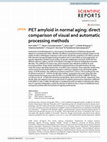
Scientific Reports, 2020
Assessment of amyloid deposits is a critical step for the identification of Alzheimer disease (AD... more Assessment of amyloid deposits is a critical step for the identification of Alzheimer disease (AD) signature in asymptomatic elders. Whether the different amyloid processing methods impacts on the quality of clinico-radiological correlations is still unclear. We directly compared in 155 elderly controls with extensive neuropsychological testing at baseline and 4.5 years follow-up three approaches: (i) operator-dependent standard visual reading, (ii) operator-independent automatic SUVR with four different reference regions, and (iii) novel operator and region of reference-independent automatic Aβ-index. The coefficient of variance was used to examine inter-individual variability for each processing method. Using visually-established amyloid positivity as the gold standard, the area under the receiver operating characteristic curve (ROC) was computed. Linear regression models were used to assess the association between changes in continuous cognitive score and amyloid uptake values. I...
Frontiers in Neuroscience, 2019
Aging-Related Amyloid and MRI Conclusion: The progressive decrement of neuropsychological perform... more Aging-Related Amyloid and MRI Conclusion: The progressive decrement of neuropsychological performances in normal aging is associated with volume loss and WM microstructure changes in hippocampus long before the emergence of clinically overt symptoms. Higher amyloid load in hippocampus is compatible with cognitive preservation in cases with better preservation of GM densities and WM microstructure in this area.

Nutrients, 2018
Coffee, wine and chocolate are three frequently consumed substances with a significant impact on ... more Coffee, wine and chocolate are three frequently consumed substances with a significant impact on cognition. In order to define the structural and cerebral blood flow correlates of self-reported consumption of coffee, wine and chocolate in old age, we assessed cognition and brain MRI measures in 145 community-based elderly individuals with preserved cognition (69 to 86 years). Based on two neuropsychological assessments during a 3-year follow-up, individuals were classified into stable-stable (52 sCON), intermediate (61 iCON) and deteriorating-deteriorating (32 dCON). MR imaging included voxel-based morphometry (VBM), tract-based spatial statistics (TBSS) and arterial spin labelling (ASL). Concerning behavior, moderate consumption of caffeine was related to better cognitive outcome. In contrast, increased consumption of wine was related to an unfavorable cognitive evolution. Concerning MRI, we observed a negative correlation of wine and VBM in bilateral deep white matter (WM) regions...










Uploads
Papers by Cristelle Rodriguez